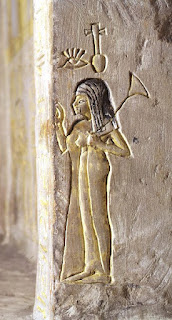Stela of Amenhotep
This rectangular stela with a cavetto cornice and a torus moulding has been crowned with another triangle which represents a pyramidion. In this context the decoration of the solar disk over water lines, the udjat-eyes and the cup are entirely fitting. These elements are also found in the top sections of other stelae. A winged disk has been added to the cavetto cornice. A border with inscription surrounds the stela's interior, which has been divided into two registers with the usual contents. Above is the veneration by the deceased of Osiris followed by the Goddess of the West, the Mistress of the Necropolis. Below is the funerary offering for Amenhotep's parents, which is brought by Amenhotep and his wife Kia, as well as a smaller representation of the ritual priest of Ptah, Pa-tir. The images and hieroglyphs have been painted in a dull yellow, symbolizing the golden light of the sun. The monument is thus also dedicated to the cult of the parents. The same situation applies to another three stelae erected by Amenhotep, usually designated with the abbreviation Huy, now in Vienna, Naples, and Rio de Janeiro.
Present location | KUNSTHISTORISCHES MUSEUM [09/001] VIENNA |
Inventory number | 178 |
Dating | 19TH DYNASTY (not before); SETHOS I/MENMAATRE ?; 19TH DYNASTY (not after) |
Archaeological Site | UNKNOWN |
Category | STELA |
Material | LIMESTONE |
Technique | HEWN; CARVED; ENGRAVED |
Height | 120 cm |
Width | 70.2 cm |
Depth | 13 cm |
Translation
2a) An offering which the king gives to Osiris, Foremost of the West, the great god, the ruler of eternity. Greetings to you, lords of everlastingness, who go as crew of heaven, as crew of the hourly service, who live forever! I have presented you with Maat. I cause Maat to ascend to you. For the Ka of the scribe of the table, Amenhotep.
2b) An offering which the king gives to Ptah-Sokar, the Lord of Shetit. I desire transformation in the necropolis. I have come to you, Lord of Ta-djeser, Osiris, Foremost of the West, so that you may give transformation in heaven, power on earth, and justification in the necropolis to the Ka of the scribe of the table of the Lord of the Two Lands, Huy, true of voice.
3) Osiris, Foremost of the West,
4) the great god, the Lord of Eternity,
5) the Lord of the Throne of Everlastingness.
6) The beautiful goddess of the West, the Mistress of Everlastingness.
7) Adoring Ptah-Sokar,
8) Praising Osiris,
9) Kissing the earth in front of
10) the Lord of Ta-djeser
11/12) by the Scribe of the Table of
13) the Lord of the Two Lands, the Master of Festivals
14) of Osiris, Amenhotep.
15) The Osiris, the Staff-bearer
16) of the Lord of the Two Lands,
17) Pehui true of voice.
26) Tii true of voice
18) An offering of all
19) good and pure things, bread and
20) beer, meat and poultry
21) by his son,
22) the Scribe of the Table of the Lord of the Two Lands, Huy
23) His sister, whom he loves, the mistress of the house,
24) Ki.
25) The lector priest of Ptah, Pa-tir.
Bibliography
- Lieblein. J., Dictionnaire de noms hiéroglyphiques (1871) 216, Nr. 644.
- Bergmann, E. von, Übersicht der ägyptischen Alterthümer (1876) 39, Nr. 115; (21878) 36, Nr. 115; (61886) 39, Nr. 115.
- Bergmann, E. von, Inschriftliche Denkmäler I, in: Recueil de Travaux rélatifs à la philologie et à l'archéologie égyptiennes et assyriennes (RecTrav) 7 (1886) Nr.12.
- Satzinger, H., Das Kunsthistorische Museum in Wien. Die Ägyptisch-Orientalische Sammlung. Zaberns Bildbände zur Archäologie 14. Mainz. 1994.
- Seipel, W. (ed.), Götter Menschen Pharaonen, Speyer (1993) = Dioses, Hombres, Faraones, Ciudad de México (1993) = Das Vermächtnis der Pharaonen, Zürich (1994).


No hay comentarios:
Publicar un comentario